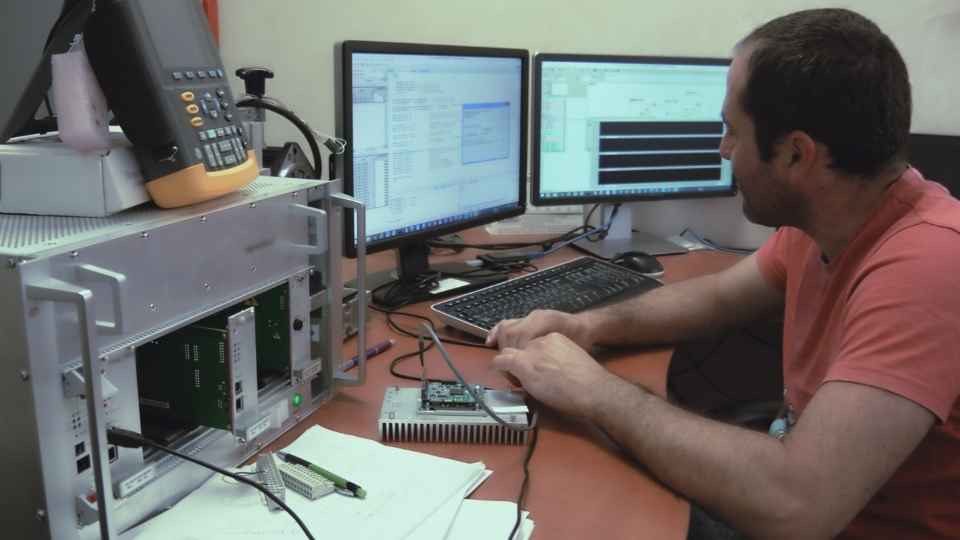
Hey there! Did you know that radio frequency (RF) technology is all around us, playing a crucial role in our daily lives?
From wireless communication to satellite transmissions, RF is the driving force behind it all.
In this article, I'll take you on a journey from the basics of antenna design to unraveling the mysteries of radio waves.
We'll explore different frequency bands and learn how RF amplifiers enhance signal transmission.
So, get ready to dive into the fascinating world of RF technology and discover its amazing capabilities!
Key Takeaways
- Antenna design is crucial for radio wave transmission, with factors such as frequency range, gain, directivity, and impedance matching being important considerations.
- Wireless communication principles involve the conversion of information into electromagnetic signals, propagation through space as radio waves, and conversion back into information at the receiver.
- Understanding frequency bands is essential for optimizing wireless systems, as they determine the range of signal transmission and reception, bandwidth, interference levels, and range capabilities.
- RF amplifiers play a significant role in boosting signal strength, providing impedance matching capabilities, and can be tailored to specific frequency ranges.
The Basics of Antenna Design
The basics of antenna design include understanding how different shapes and sizes affect radio wave transmission. When it comes to designing an antenna, one must consider various factors, such as the frequency range, gain, directivity, and impedance matching. These elements play a crucial role in optimizing the performance of an antenna system.
The shape of an antenna greatly influences its radiation pattern and efficiency. For example, a dipole antenna consists of two conductive elements that are aligned along the same axis. This design allows for omnidirectional radiation in the horizontal plane but limited radiation in the vertical plane.

Size also plays a critical role in antenna design. Generally, larger antennas offer higher gain and directivity due to their increased surface area for signal capture. However, smaller antennas can be more practical for certain applications where space is limited.
Understanding Wireless Communication Principles
Understanding wireless communication principles involves grasping the concept of how information is transmitted through the air using radio waves. In order to achieve this, it's important to have a clear understanding of the various components involved in wireless communication systems.
One key element is the transmitter, which converts information into electromagnetic signals and transmits them through an antenna. These signals are then propagated through space as radio waves. The receiver, equipped with its own antenna, captures these radio waves and converts them back into meaningful information. This process of transmitting and receiving data wirelessly allows for seamless communication over long distances without the need for physical connections.
To fully comprehend wireless communication principles, it's essential to explore different frequency bands that play a crucial role in determining signal strength, range, and interference levels.
Transitioning into the subsequent section about 'exploring different frequency bands', we'll now delve deeper into how these bands affect wireless communication systems.
Exploring Different Frequency Bands
To gain a better understanding of wireless communication principles, you should explore the different frequency bands and how they impact the performance of your system. Frequency bands determine the range in which signals are transmitted and received. Here are three key factors to consider:
Bandwidth: Different frequency bands offer varying levels of available bandwidth, which affects the amount of data that can be transmitted at once. Higher frequency bands generally provide larger bandwidths for faster data transfer.

Interference: The choice of frequency band can also impact interference from other devices or signals. Some bands may experience more interference than others, leading to potential disruptions in signal quality.
Range: Different frequency bands have different propagation characteristics, affecting their range capabilities. Lower-frequency bands tend to have a longer range but lower data rates, while higher-frequency bands have shorter ranges but higher data rates.
Understanding these nuances will help you optimize your wireless system for better performance and freedom from unwanted limitations.
The Role of RF Amplifiers in Signal Transmission
RF amplifiers play a crucial role in boosting the strength of signals for effective transmission. These amplifiers are essential components in communication systems, enabling the transfer of information across various frequency bands. By increasing the power level of radio frequency signals, RF amplifiers ensure that the transmitted data reaches its intended destination with clarity and reliability.
One key aspect of RF amplifiers is their ability to amplify weak signals without introducing excessive noise or distortion. This ensures that the original signal remains intact and faithfully reproduced at higher power levels. Additionally, RF amplifiers provide impedance matching capabilities, optimizing the signal transfer between different stages of a communication system.
For those seeking freedom in their communication endeavors, RF amplifiers offer flexibility and versatility. They can be tailored to specific frequency ranges, allowing users to transmit signals over long distances or through challenging environments. Furthermore, advancements in amplifier technology have resulted in smaller form factors and increased efficiency, making them suitable for portable devices such as smartphones and wireless routers.
Unraveling the Mystery of Radio Waves
Unraveling the mystery of radio waves can be an exciting journey into the world of wireless communication. As someone who craves freedom and desires to understand how these invisible signals can transmit information across vast distances, I've embarked on this enlightening exploration. Here are three awe-inspiring facts that will surely evoke an emotional response in you:

Radio waves travel at the speed of light, allowing us to communicate effortlessly across continents in mere seconds.
These electromagnetic waves possess incredible versatility, enabling us to transmit not only voice but also data, images, and even video.
The ability to harness radio waves has revolutionized our lives, granting us the freedom to connect with loved ones, access a wealth of knowledge, and explore new frontiers without physical boundaries.
Frequently Asked Questions
How Do Antennas Pick up Radio Signals From the Surrounding Environment?
Antennas pick up radio signals by converting electromagnetic waves into electrical currents. These currents are then amplified and processed to extract the desired information. It's a fascinating process that allows us to receive and transmit wireless communication.
What Are Some Common Challenges Faced in Designing Effective Antennas?
When designing antennas, common challenges include achieving desired gain and directivity, minimizing interference and signal loss, optimizing bandwidth and frequency response, and ensuring durability and reliability in various environmental conditions.
Different frequency bands have varying effects on wireless communication range and performance. Higher frequency bands provide faster data rates but have shorter range, while lower frequency bands offer slower speeds but greater coverage distance.
What Is the Purpose of RF Amplifiers in Signal Transmission and How Do They Work?
RF amplifiers are essential for boosting the strength of signals in transmission. They act as powerhouses, intensifying the radio waves to cover larger distances and improve overall performance. This is achieved by increasing the amplitude and voltage of the signals.

How Do Radio Waves Propagate Through Different Mediums, Such as Air, Water, or Buildings?
Radio waves propagate through different mediums by oscillating electric and magnetic fields. In air, they travel in straight lines at the speed of light. In water or buildings, their path may be obstructed, causing reflection, absorption, or diffraction.
 Basic Electronics ConceptsEssential ToolsCircuit Design BasicsMicrocontrollersDIY Electronics ProjectsRoboticsPrivacy PolicyTerms And Conditions
Basic Electronics ConceptsEssential ToolsCircuit Design BasicsMicrocontrollersDIY Electronics ProjectsRoboticsPrivacy PolicyTerms And Conditions
